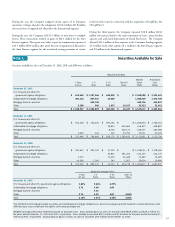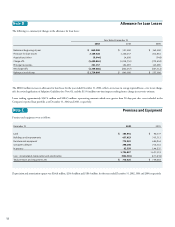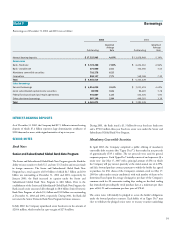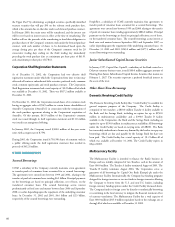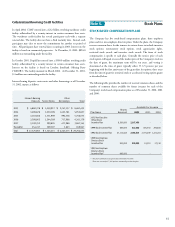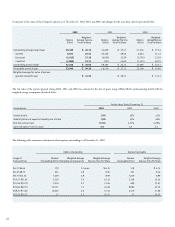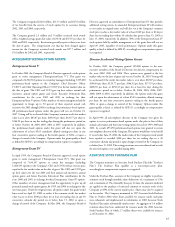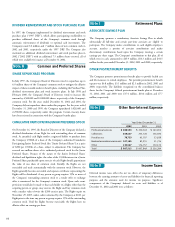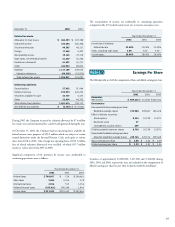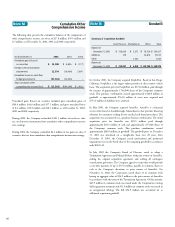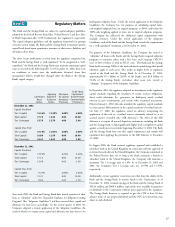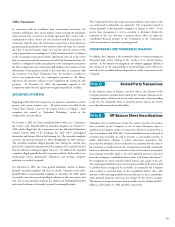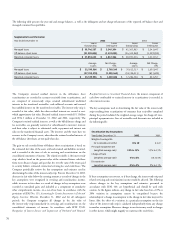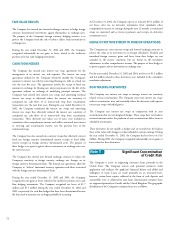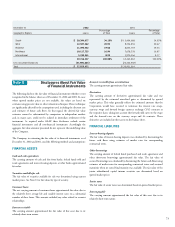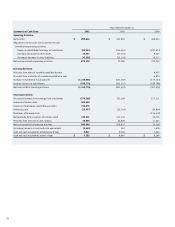Capital One 2002 Annual Report Download - page 69
Download and view the complete annual report
Please find page 69 of the 2002 Capital One annual report below. You can navigate through the pages in the report by either clicking on the pages listed below, or by using the keyword search tool below to find specific information within the annual report.
67
held against subprime loans. Under the revised application of the Subprime
Guidelines, the Company has, for purposes of calculating capital ratios,
risk weighted subprime loans in targeted programs at 200%, rather than the
100% risk weighting applied to loans not in targeted subprime programs.
The Company has addressed the additional capital requirements with
available resources. Under the revised application of the Subprime
Guidelines, each of the Bank and the Savings Bank exceeds the requirements
for a “well-capitalized” institution as of December 31, 2002.
For purposes of the Subprime Guidelines, the Company has treated as
“subprime” all loans in the Bank’s and the Savings Bank’s targeted subprime
programs to customers either with a Fair, Isaac and Company (“FICO”)
score of 660 or below or with no FICO score. The Bank and the Savings
Bank hold on average 200% of the total risk-based capital charge that would
otherwise apply to such assets. This results in higher levels of regulatory
capital at the Bank and the Savings Bank. As of December 31, 2002,
approximately $5.3 billion or 28.0% of the Bank’s, and $3.8 billion or
32.4% of the Savings Bank’s, on-balance sheet assets were treated as
“subprime” for purposes of the Subprime Guidelines.
In November 2001, the regulators adopted an amendment to the regulatory
capital standards regarding the treatment of certain recourse obligations,
direct credit substitutes (i.e., guarantees on third-party assets), residual
interests in asset securitizations, and certain other securitized transactions.
Effective January 1, 2002, this rule amended the regulatory capital standards
to create greater differentiation in the capital treatment of residual interests.
On May 17, 2002, the regulators issued an advisory interpreting the
application of this rule to a residual interest commonly referred to as an
accrued interest receivable (the “AIR Advisory”). The effect of this AIR
Advisory is to require all insured depository institutions, including the Bank
and the Savings Bank, to hold significantly higher levels of regulatory capital
against accrued interest receivables beginning December 31, 2002. The Bank
and the Savings Bank have met this capital requirement and remain well
capitalized after applying the provisions of the AIR Advisory at December
31, 2002.
In August 2000, the Bank received regulatory approval and established a
subsidiary bank in the United Kingdom. In connection with the approval of
its former branch office in the United Kingdom, the Company committed to
the Federal Reserve that, for so long as the Bank maintains a branch or
subsidiary bank in the United Kingdom, the Company will maintain a
minimum Tier 1 Leverage ratio of 3.0%. As of December 31, 2002 and
2001, the Company’s Tier 1 Leverage ratio was 11.95% and 11.93%,
respectively.
Additionally, certain regulatory restrictions exist that limit the ability of the
Bank and the Savings Bank to transfer funds to the Corporation. As of
December 31, 2002, retained earnings of the Bank and the Savings Bank of
$924.4 million and $408.4 million, respectively, were available for payment
of dividends to the Corporation without prior approval by the regulators.
The Savings Bank, however, is required to give the OTS at least 30 days
advance notice of any proposed dividend and the OTS, in its discretion, may
object to such dividend.
Note O Regulatory Matters
The Bank and the Savings Bank are subject to capital adequacy guidelines
adopted by the Federal Reserve Board (the “Federal Reserve”) and the Office
of Thrift Supervision (the “OTS”) (collectively, the “regulators”), respectively.
The capital adequacy guidelines and the regulatory framework for prompt
corrective action require the Bank and the Savings Bank to maintain specific
capital levels based upon quantitative measures of their assets, liabilities and
off-balance sheet items.
The most recent notifications received from the regulators categorized the
Bank and the Savings Bank as “well-capitalized.” To be categorized as “well-
capitalized,” the Bank and the Savings Bank must maintain minimum capital
ratios as set forth in the following table. As of December 31, 2002, there were
no conditions or events since the notifications discussed above that
management believes would have changed either the Bank or the Savings
Bank’s capital category.
To Be “Well
Applying Minimum Capitalized”
Call Report Subprime for Capital Under Prompt
Basis Guidance Adequacy Corrective Action
Ratios Ratios Purposes Provisions
December 31, 2002
Capital One Bank
Tier 1 Capital 15.56% 11.50% 4.00% 6.00%
Total Capital 17.78 13.39 8.00 10.00
Tier 1 Leverage 13.79 13.79 4.00 5.00
Capital One, F.S.B.
Tier 1 Capital 15.10% 11.02% 4.00% 6.00%
Total Capital 16.80 12.59 8.00 10.00
Tier 1 Leverage 14.45 14.45 4.00 5.00
December 31, 2001
Capital One Bank
Tier 1 Capital 12.95% 4.00% 6.00%
Total Capital 15.12 8.00 10.00
Tier 1 Leverage 12.09 4.00 5.00
Capital One, F.S.B.
Tier 1 Capital 9.27% 4.00% 6.00%
Total Capital 11.21 8.00 10.00
Tier 1 Leverage 8.86 4.00 5.00
Since early 2001, the Bank and Savings Bank have treated a portion of their
loans as “subprime” under the “Expanded Guidance for Subprime Lending
Programs” (the “Subprime Guidelines”) and have assessed their capital and
allowance for loan losses accordingly. In the second quarter of 2002, the
Company adopted a revised application of the Subprime Guidelines, the
result of which is to require more capital and allowance for loan losses to be


